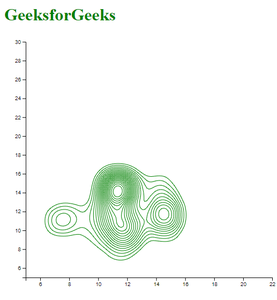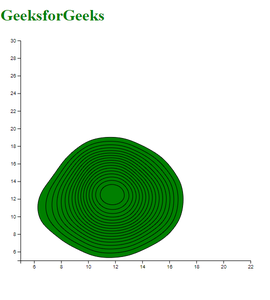d3.contourDensity()函数用于使用默认设置构造一个新的密度估计器函数。密度估算器函数估算给定数据集的密度。
用法:
d3.contourDensity();
参数:此函数不带任何参数。
返回值:该函数返回一个函数。
下面给出的是上面给出的函数的一些例子。
范例1:
<!DOCTYPE html>
<html lang="en">
<head>
<meta charset="UTF-8">
<meta name="viewport" content="
width=device-width, initial-scale=1.0">
<script type="text/javascript"
src="https://d3js.org/d3.v4.min.js">
</script>
<script src="https://d3js.org/d3-contour.v1.min.js">
</script>
</head>
<body>
<h1 style="color:green">GeeksforGeeks</h1>
<script>
// append the svg object to the body.
var svg = d3.select("body")
.append("svg")
.attr("width", 530)
.attr("height", 480)
.append("g")
.attr("transform",
"translate(" + 40 + ", " + 0 + ")");
// Read data
d3.csv("./data.csv", function(data) {
var y = d3.scaleLinear()
.domain([5, 30])
.range([ 450, 10 ]);
var x = d3.scaleLinear()
.domain([5, 22])
.range([ 0, 460]);
svg.append("g")
.call(d3.axisLeft(y));
svg.append("g")
.attr("transform","translate(0, " + 450 + ")")
.call(d3.axisBottom(x));
var densityData = d3.contourDensity()
.y(function(d) { return y(d.y); })
.x(function(d) { return x(d.x); })(data)
svg.selectAll("path")
.data(densityData)
.enter()
.append("path")
.attr("d", d3.geoPath())
.attr("fill", "none")
.attr("stroke", "green")
});
// Data for csv file
// x, y, group
// 11.45, 14.2, H
// 11.1, 14.2, H
// 11.9, 9.9, H
// 11.6, 14.5, H
// 11.1, 11.7, H
// 14.7, 9.5, H
// 7.9, 11.6, H
// 14.7, 11.7, H
// 11.45, 14.2, H
// 12.1, 9.2, H
// 7.5, 11, H
// 14.5, 14.5, H
// 11.45, 9.7, H
// 14.45, 11.6, H
// 11.5, 7.6, H
// 11, 11.45, H
// 14.7, 12, H
// 11.7, 9.7, H
// 9.6, 9, H
// 12, 11, H
// 11.45, 14.5, H
// 11.11, 14.6, H
// 12.7, 11.11, H
// 11, 12.2, H
// 11, 14.9, H
// 9.5, 11.7, H
// 11.7, 14.7, H
// 11.9, 14.5, H
// 14, 14.5, H
// 7.11, 11, H
// 11.11, 11.45, H
// 11, 14.2, H
// 14.7, 11.7, H
// 14.5, 11.9, H
</script>
</body>
</html> 输出:

范例2:
<!DOCTYPE html>
<html lang="en">
<head>
<meta charset="UTF-8">
<meta name="viewport" content="
width=device-width, initial-scale=1.0">
<script type="text/javascript"
src="https://d3js.org/d3.v4.min.js">
</script>
<script src="https://d3js.org/d3-contour.v1.min.js">
</script>
</head>
<body>
<h1 style="color:green">GeeksforGeeks</h1>
<script>
// Append the svg object to the body.
var svg = d3.select("body")
.append("svg")
.attr("width", 530)
.attr("height", 480)
.append("g")
.attr("transform",
"translate(" + 40 + ", " + 0 + ")");
// Read data
d3.csv("./data.csv", function(data) {
var y = d3.scaleLinear()
.domain([5, 30])
.range([ 450, 10 ]);
var x = d3.scaleLinear()
.domain([5, 22])
.range([ 0, 460]);
svg.append("g")
.call(d3.axisLeft(y));
svg.append("g")
.attr("transform","translate(0, " + 450 + ")")
.call(d3.axisBottom(x));
var densityData = d3.contourDensity()
.y(function(d) { return y(d.y); })
.bandwidth(44)
.x(function(d) { return x(d.x); })(data)
svg.selectAll("path")
.data(densityData)
.enter()
.append("path")
.attr("d", d3.geoPath())
.attr("fill", "green")
.attr("stroke", "black")
});
// Data for csv file
// x, y, group
// 11.45, 14.2, H
// 11.1, 14.2, H
// 11.9, 9.9, H
// 11.6, 14.5, H
// 11.1, 11.7, H
// 14.7, 9.5, H
// 7.9, 11.6, H
// 14.7, 11.7, H
// 11.45, 14.2, H
// 12.1, 9.2, H
// 7.5, 11, H
// 14.5, 14.5, H
// 11.45, 9.7, H
// 14.45, 11.6, H
// 11.5, 7.6, H
// 11, 11.45, H
// 14.7, 12, H
// 11.7, 9.7, H
// 9.6, 9, H
// 12, 11, H
// 11.45, 14.5, H
// 11.11, 14.6, H
// 12.7, 11.11, H
// 11, 12.2, H
// 11, 14.9, H
// 9.5, 11.7, H
// 11.7, 14.7, H
// 11.9, 14.5, H
// 14, 14.5, H
// 7.11, 11, H
// 11.11, 11.45, H
// 11, 14.2, H
// 14.7, 11.7, H
// 14.5, 11.9, H
</script>
</body>
</html> 输出:

相关用法
- PHP imagecreatetruecolor()用法及代码示例
- p5.js year()用法及代码示例
- d3.js d3.utcTuesdays()用法及代码示例
- PHP ImagickDraw getTextAlignment()用法及代码示例
- PHP Ds\Sequence last()用法及代码示例
- PHP array_udiff_uassoc()用法及代码示例
- PHP geoip_continent_code_by_name()用法及代码示例
- d3.js d3.map.set()用法及代码示例
- PHP GmagickPixel setcolor()用法及代码示例
- PHP opendir()用法及代码示例
- PHP cal_to_jd()用法及代码示例
- d3.js d3.bisectLeft()用法及代码示例
- PHP stream_get_transports()用法及代码示例
- PHP Ds\Deque pop()用法及代码示例
注:本文由纯净天空筛选整理自tarun007大神的英文原创作品 D3.js contourDensity() Function。非经特殊声明,原始代码版权归原作者所有,本译文未经允许或授权,请勿转载或复制。
